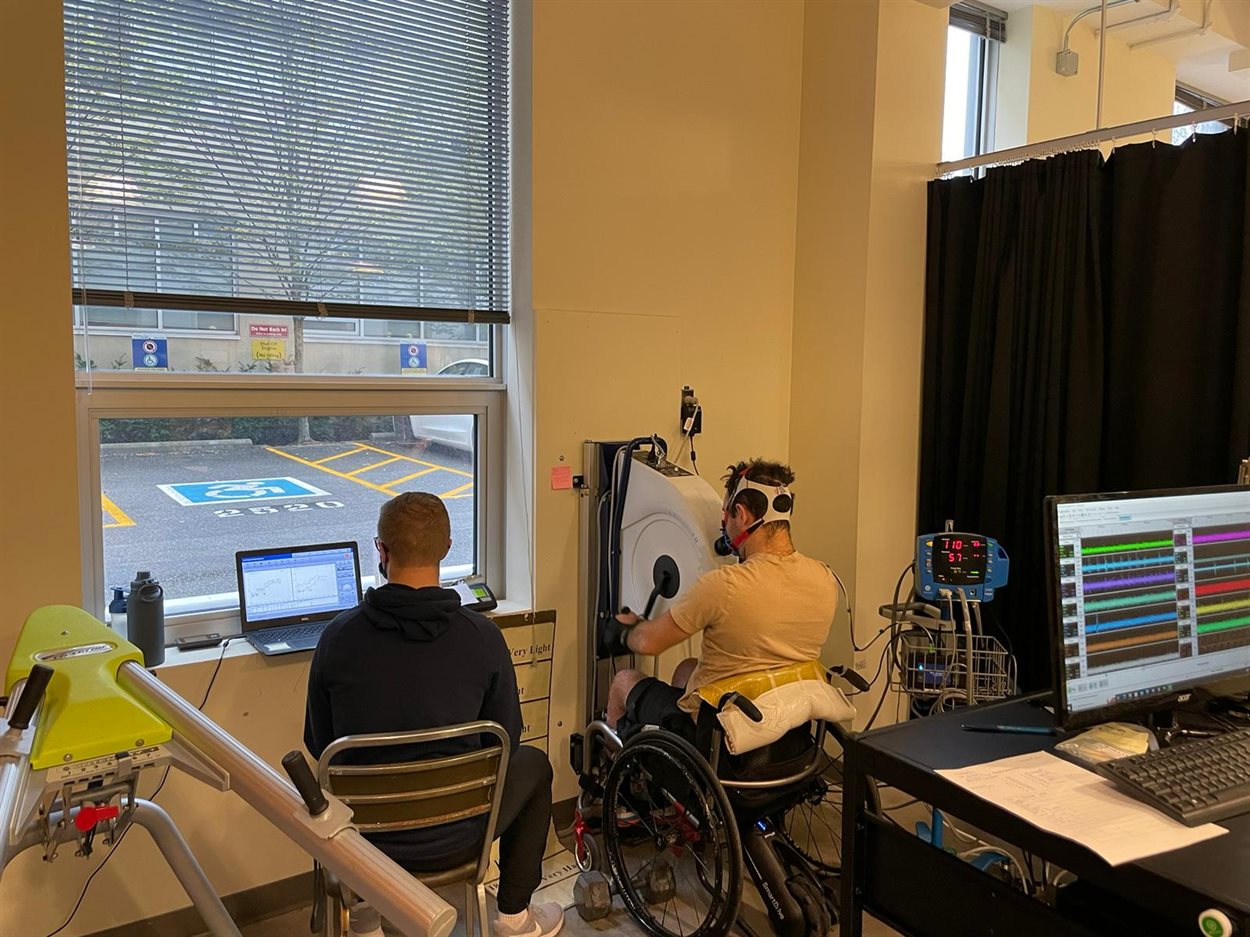About the study
High-level spinal cord injury (SCI ≥T6) results in disturbances to autonomic cardiovascular function. During exercise, these individuals typically have a lower blood pressure, heart rate and stroke volume, among other cardiovascular outcomes, that ultimately limits exercise performance and overall physical capacity. Overtime, this can significantly increase the risk of cardiovascular disease (e.g., stroke or heart attack) to a greater extent than the general population.
Epidural spinal cord stimulation (involving implanted electrodes and a stimulator) has recently resolved low blood pressure and improved exercise performance in an individual with tetraplegia (Nightingale et al., 2019), yet this requires an invasive and expensive surgical procedure that is not routinely offered in the UK. Preliminary work from our research group has revealed improvements in cardiovascular control and exercise performance with non-invasive transcutaneous spinal cord stimulation (TSCS) in a small group of individuals, but this needs to be explored further.
What is transcutaneous spinal cord stimulation (TSCS)?
TSCS is a non-invasive form of electrical stimulation that is applied over the skin surface at specific levels of the spinal cord. The electrical stimulation is delivered using sticky electrodes that are plugged into a stimulator device (see image on the right). Using this device, we aim to activate the spinal circuitries by increasing the intensity of the stimulation until we observe a safe but beneficial elevation in blood pressure. We are calling this “cardiovascular-optimised TSCS”.

How to get involved:
Individuals must meet the following criteria to be eligible to take part:
- Male or female at least 16 years of age
- Chronic SCI (at least 1-year post-injury)
- Motor-complete SCI (American Spinal Injury Association Impairment Scale Grade A or B)
- SCI between C5-T6
- English speaking
- Can move arms/hands voluntarily without the need of support
Please see Page 4 of the Participant Information Sheet to read the full eligibility criteria.
What is involved?
- This project is formed of two parts: AIM 1 and AIM 2.
- AIM 1 lasts 3 weeks with a total time commitment of approx. 11.5 hours, split across 5 assessment visits.
- AIM 2 lasts 9 weeks plus a 6-week follow-up period with a total time commitment of approx. 34 hours. This consists of 16 exercise sessions (2 sessions per week for 8 weeks) and 6 assessment visits.
- Participants can choose to take part in AIM 1 only if they do not want to take part in AIM 2.
AIM 1 consists of the following:
A stimulation mapping session, recordings of your heart rate and blood pressure responses to a series of tests, as well as an arm-crank fitness test. Participants will then perform arm-crank exercise trials to exhaustion (approx. 30 - 40 minutes), with and without stimulation. Blood samples will be taken before and after exercise.
AIM 2 consists of the following:
All assessments are completed before and after the exercise intervention. These include blood sampling, cardiovascular health, cognitive function, and balance assessments. Participants will also be asked if they’d like to answer some questionnaires on their pain, bowel, bladder and sexual function. They will wear an activity monitor on their chest for 3 days to monitor physical activity and heart rate, A blood pressure cuff will also be worn for a 24-hour period. Following the intervention, the same heart rate and blood pressure responses tests performed in AIM 1 will be completed.
The exercise intervention will consist of two arm-crank exercise sessions per week for eight weeks. Participants will be randomised into two groups: one exercising with cardiovascular-optimised stimulation and the other exercising with a sham/control stimulation. These sessions will last approx. 48 minutes, consisting of 6 bouts of 3-min high intensity followed by 2-min low intensity upper-body arm crank exercise.
For more information on the specific visits and assessments, we encourage you to click on the link to the participant information sheet below.
What are the benefits of taking part?
- Participants are eligible to receive £40 per assessment visit and £200 for completing the exercise intervention.
- Completing all assessment visits and exercise intervention sessions will earn participants a total of £640.
Click here to view the participant information sheet.